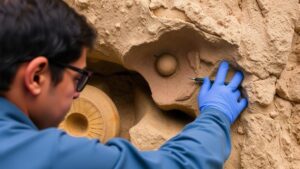Riverbeds of Time: Fossilized Logs and Prehistoric Fish Preserved in Stone
Riverbeds of Time: Fossilized Logs and Prehistoric Fish Preserved in Stone
For rockhounds and mineral collectors, the discovery of fossilized logs and prehistoric fish provides not just an exciting find, but also a glimpse into a world that existed millions of years ago. These extraordinary specimens not only showcase the beauty of natural history but serve as valuable tools for understanding ancient ecosystems. In this article, we will explore the processes behind fossilization, the significance of these specimens, and practical tips for collectors interested in incorporating these unique finds into their collections.
The Fossilization Process
Fossilization is a complex process that can occur in various ways, but the most common methods relevant to fossilized logs and fish are permineralization and preservation in sedimentary rock.
Permanently mineralized fossils form when organic material is buried under sediment, cutting off exposure to oxygen. Over time, groundwater rich in dissolved minerals infiltrates the tissues. This process not only preserves the shape of the original organism but can also lead to the replacement of organic matter with minerals like silica, calcite, or pyrite. For example, a fossilized log may become a striking piece of petrified wood, often showcasing vibrant colors due to mineral inclusions.
On the other hand, fossilized fish are often found in sedimentary deposits where their remains were quickly buried in anoxic (low-oxygen) environments, preventing decay. Their delicate features can be preserved in fine detail, including scales and fins. The Green River Formation in Wyoming and the Solnhofen Limestone in Germany are renowned for their exceptional preservation of fossils, including fish dating back to the Eocene period, approximately 56 to 34 million years ago.
Significance of Fossilized Specimens
Fossilized logs and prehistoric fish are important not only for collectors but also for scientists studying Earths history. e specimens provide insight into ancient climate conditions, ecosystems, and even evolutionary changes. Consider the following points:
- Environmental Indicators: Fossilized logs can point to past climate conditions. For example, the presence of certain tree species can indicate what type of environment existed at the time, such as swampy or dry habitats.
- Evolutionary Insights: Prehistoric fish fossils can help scientists trace the evolutionary lineage of modern species. study of their physical features sheds light on how aquatic life has adapted over millions of years.
Rockhounding and Fossil Collecting Tips
For those who wish to collect fossilized logs and prehistoric fish, preparation and knowledge are key. Here are some actionable tips that can enhance your collecting experience:
- Do Your Research: Before going out, understand the local geology and fossil sites in your area. Popular fossil-rich locations include the western United States, particularly the Ohio River Valley for logs, and the Green River Formation for fish.
- Invest in Proper Tools: Essential tools include a sturdy rock hammer, chisels, a field guide for identification, and safety gear like gloves and goggles.
- Respect Regulations: Always check local laws regarding fossil collection. Some areas may require permits or prohibit collecting altogether, especially within national parks.
- Practice Proper Preservation: Once you acquire fossil specimens, ensure they are stored appropriately to prevent damage. Use padded boxes or display cases that protect them from light and moisture.
Real-World Applications for Collectors
Incorporating fossilized logs and prehistoric fish into a collection goes beyond mere aesthetics. These specimens can serve as educational tools for understanding paleontology and geology. For example:
- Educational Displays: Create an educational showcase that highlights the significance of your fossils. Include information about the species, their environment, and fossilization processes to inform visitors or fellow enthusiasts.
- Networking and Community Sharing: Join local rockhounding or paleontology clubs to share findings and gain insights from more experienced collectors. This network can provide valuable knowledge and access to fossil sites.
Conclusion
The quest for fossilized logs and prehistoric fish is an exciting journey through time for rockhounds and mineral collectors alike. By understanding the processes of fossilization, the significance of these specimens, and adhering to best practices in collecting, enthusiasts can amass a collection that not only thrills but educates. As you embark on this adventure, remember that every fossil holds a story waiting to be unveiled–making each find a priceless piece of Earths history.



